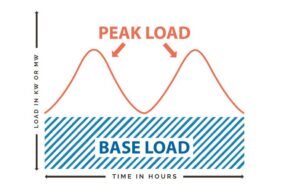Electricity Load Factor
Understanding Electricity Load Factor: Optimizing Efficiency for Businesses Electricity is an essential resource for businesses, powering everything from manufacturing processes to office operations. However, simply consuming electricity without considering its efficiency can lead to increased costs and environmental impact. One crucial aspect to consider is the electricity load factor, which plays a significant role in determining energy efficiency and cost optimization. In this article, we will explore the concept of load factor, its importance, and how businesses can strive for a better load factor to enhance their operational efficiency.
 What is Load Factor?
What is Load Factor?
Load factor is a measurement that assesses the efficiency of electricity usage within a given period, typically a month or a year. It is the ratio of the average power demand to the maximum power demand during that specific period. Load factor is expressed as a percentage and provides insights into how consistently and effectively a business utilizes electrical power.
A load factor of 100% indicates that a business is operating at its maximum power demand throughout the entire billing cycle, implying optimal energy utilization. Conversely, a load factor significantly below 100% indicates a discrepancy between the maximum capacity and actual usage, signifying potential inefficiencies in energy consumption.
Importance of Load Factor
Understanding and improving load factor is crucial for businesses for several reasons. Firstly, a higher load factor leads to increased energy efficiency, as it implies a more consistent utilization of available power resources. This, in turn, helps reduce energy wastage and associated costs.
Secondly, a better load factor enables businesses to optimize their infrastructure, as it allows for better planning and allocation of electrical resources. By identifying periods of high or low demand, businesses can adjust their operations and schedule energy-intensive tasks during off-peak hours, taking advantage of lower electricity tariffs.
Furthermore, an improved load factor helps businesses reduce their environmental footprint. By reducing energy waste and optimizing power usage, companies can lower their greenhouse gas emissions, contributing to a more sustainable future.
Understanding Load Factor for Commercial Electricity Supply: Why It’s Important
What Is Load Factor in Commercial Electricity Supply?
The load factor is a key metric in determining how efficiently a business uses electricity over time. It measures the ratio of your actual energy consumption compared to your maximum possible consumption if you were using electricity at full capacity every hour of the month. A higher load factor signifies that a business is using energy more consistently and efficiently, leading to lower energy rates. On the other hand, a lower load factor means that the business uses electricity in a more sporadic or seasonal way, which can drive up energy costs.
Why Is a Good Load Factor Important?
A good load factor is essential for businesses because it directly influences energy costs. Energy providers often charge based on both usage and demand. If your business has periods of high demand followed by times of little or no usage, your load factor will be low, and energy providers may charge you higher rates to compensate for the uneven demand. Conversely, a high load factor means you’re using electricity at a more constant rate, which can lead to lower costs due to better pricing structures offered by suppliers.
The Impact of Seasonal Businesses on Load Factor
Businesses with a seasonal nature tend to have poor load factors. These businesses operate at high demand during certain months and much lower demand during others. This erratic use of electricity creates inefficiency from an energy consumption standpoint and can result in higher energy costs.
Examples of Seasonal Businesses with Poor Load Factors:
- Ski Resorts
Ski resorts experience peak energy consumption during the winter months when they are fully operational. However, during off-season periods, their electricity usage drops significantly. This uneven demand leads to a poor load factor, which increases the resort's energy rates. - Summer Amusement Parks
Like ski resorts, amusement parks consume large amounts of electricity during the summer season but significantly reduce consumption in the off-season. This fluctuation in energy usage results in higher rates due to a poor load factor. - Seasonal Agricultural Operations
Farming businesses that rely on specific growing seasons also face the same challenge. During planting and harvesting periods, energy use spikes, but during off-seasons, it drops drastically, creating an inconsistent demand pattern and a low load factor.
Businesses with Good Load Factors
Certain types of businesses naturally maintain a more consistent energy usage, resulting in higher load factors and lower energy costs.
Examples of Businesses with Good Load Factors:
- Manufacturing Plants
Manufacturing plants often operate on a 24/7 schedule, maintaining consistent energy use throughout the day and year. This steady demand results in a high load factor, allowing manufacturers to benefit from lower electricity rates. - Hospitals
Hospitals need to operate continuously, regardless of the time of year. Their constant energy demand ensures a high load factor, which helps them secure more favorable energy pricing. - Data Centers
Data centers, which run around the clock to manage and store digital information, also have a high load factor. Their constant electricity usage makes them efficient energy consumers, allowing them to negotiate better electricity rates.
How to Improve Your Business's Load Factor
Businesses that want to lower their electricity costs should focus on improving their load factor. Here are a few strategies to consider:
- Monitor and Adjust Energy Usage
Conduct an energy audit to identify periods of high and low usage. By adjusting operational schedules to spread out energy use more evenly, businesses can improve their load factor and reduce energy costs. - Invest in Energy Efficiency
Implementing energy-efficient technologies can help smooth out demand throughout the day. For example, installing energy-efficient HVAC systems, lighting, and equipment can help maintain a steady energy consumption pattern. - Consider Load Shifting
Some businesses can shift energy usage from peak demand times to off-peak periods when electricity rates are lower. This helps avoid high charges during peak times and improves overall energy efficiency. - Use Automation
Automated systems can help monitor and regulate energy use across different times of the day, helping businesses avoid demand spikes and maintain a more consistent energy consumption pattern.
Why Businesses Should Avoid a Bad Load Factor
A poor load factor not only leads to higher energy rates but also puts businesses at a disadvantage when negotiating electricity contracts. Energy providers often view businesses with low load factors as inefficient energy users, and they charge accordingly. Businesses with erratic or seasonal energy usage patterns, like ski resorts and summer parks, are often penalized with higher rates, which can significantly increase operational costs.
How Bid On Energy Can Help
For businesses looking to improve their load factor and reduce electricity costs, consulting with energy experts can make a significant difference. Bid On Energy is a trusted resource for businesses looking to optimize their energy consumption. They can help you:
- Analyze Your Load Factor: Bid On Energy can assess your current load factor and identify ways to improve it.
- Negotiate Better Energy Rates: With a higher load factor, businesses can negotiate lower energy rates, and Bid On Energy will help find the best pricing available.
- Provide Customized Solutions: Whether you’re a large manufacturing plant or a small seasonal business, Bid On Energy tailors energy solutions to your specific needs.
For assistance with improving your load factor and lowering your energy costs, contact Bid On Energy at 302-360-8110 or visit https://BidOnEnergy.org. They can provide a free consultation and help your business optimize its energy use for maximum efficiency and cost savings.
Today understanding and improving your business’s load factor can significantly impact your electricity costs. Seasonal businesses, like ski resorts and amusement parks, tend to have poor load factors, leading to higher rates, while businesses with consistent energy use, such as manufacturing plants, hospitals, and data centers, benefit from better pricing. By implementing energy-efficient practices, shifting loads, and monitoring energy usage, businesses can improve their load factor and reduce costs. Contact Bid On Energy for expert guidance and solutions tailored to your business’s energy needs.
Enhancing Load Factor for Businesses
To achieve a better load factor, businesses can employ several strategies and technologies. Here are some key approaches:
Energy Audits
Conducting regular energy audits can help identify areas of energy inefficiency and pinpoint opportunities for improvement. By analyzing energy consumption patterns and identifying peak demand periods, businesses can develop targeted strategies to optimize their load factor.
Load Monitoring and Control
Implementing energy monitoring systems allows businesses to track their energy usage in real-time. By closely monitoring energy patterns, businesses can identify peak demand periods and take proactive measures to mitigate sudden spikes in power consumption.
Load Shifting
Load shifting involves shifting energy-intensive tasks to off-peak hours when the demand for electricity is lower. By rescheduling operations, businesses can avoid peak demand periods, leading to a smoother and more balanced distribution of energy usage throughout the day.
Demand Response Programs
Participating in demand response programs offered by utility companies can provide financial incentives for businesses to reduce their energy consumption during periods of high demand. By voluntarily reducing their load during peak hours, businesses can not only improve their load factor but also potentially earn monetary benefits.
Energy-efficient Technologies
Adopting energy-efficient equipment and technologies can significantly impact a business's load factor. LED lighting, smart HVAC systems, and energy-efficient machinery are examples of technologies that can lower energy consumption and improve overall efficiency.
Today load factor plays a vital role in determining the efficiency and cost-effectiveness of electricity consumption for businesses. By striving for a better load factor through strategies such as energy audits, load monitoring, load shifting, participation in demand response programs, and adopting energy-efficient technologies, businesses can optimize their energy usage, reduce costs, and contribute to a more sustainable future. Understanding load factor and implementing measures to improve it will not only benefit businesses financially but also promote environmental responsibility in the realm of energy consumption.

Achieving a good load factor is a desirable goal for businesses as it signifies efficient and optimized electricity usage. Let's consider an example of a manufacturing company that has successfully attained a high load factor.
ABC Manufacturing is a medium-sized company specializing in the production of automotive parts. With a commitment to energy efficiency, ABC Manufacturing has implemented various measures to improve its load factor. Through careful analysis and planning, the company has achieved a load factor of 95%, indicating an exceptional level of efficiency in electricity consumption.
One key factor contributing to ABC Manufacturing's impressive load factor is load shifting. By leveraging flexible production schedules, the company has shifted energy-intensive processes, such as machinery operation and assembly line activities, to off-peak hours. This approach allows them to take advantage of lower electricity tariffs during non-peak periods, reducing costs and improving load factor simultaneously.
Furthermore, ABC Manufacturing has invested in energy monitoring systems to closely track and manage their energy usage. Real-time data analysis helps identify peak demand periods and enables the company to make informed decisions on load balancing and load shedding. By proactively adjusting their energy consumption patterns, they can maintain a stable and efficient load factor.
The company has also embraced energy-efficient technologies throughout its facility. They have replaced traditional lighting fixtures with LED lights, which consume significantly less electricity while providing optimal illumination. Upgraded machinery and equipment with energy-efficient models have further contributed to their high load factor. These investments not only reduce energy waste but also contribute to long-term cost savings.
Moreover, ABC Manufacturing actively participates in demand response programs offered by the local utility company. During periods of high demand, the company voluntarily reduces its electricity usage, thereby contributing to grid stability and earning financial incentives. This proactive engagement with demand response initiatives has not only improved their load factor but also established ABC Manufacturing as an environmentally conscious organization.
Today ABC Manufacturing serves as an exemplary model of a business with a good load factor. Their commitment to load shifting, energy monitoring, investment in energy-efficient technologies, and participation in demand response programs have resulted in a load factor of 95%. By prioritizing energy efficiency and employing these strategies, ABC Manufacturing has not only reduced operational costs but also demonstrated environmental responsibility in their electricity consumption practices.
